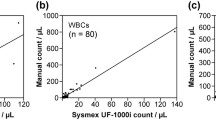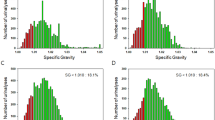Abstract
Background
We aimed to identify patients with a chief complaint of hematuria who could safely avoid unnecessary radiation and instrumentation in the diagnosis of bladder cancer (BC), using automated urine flow cytometry to detect isomorphic red blood cells (RBCs) in urine.
Methods
We acquired urine samples from 134 patients over the age of 35 years with a chief complaint of hematuria and a positive urine occult blood test or microhematuria. The data were analyzed using the UF-1000i ® (Sysmex Co., Ltd., Kobe, Japan) automated urine flow cytometer to determine RBC morphology, which was classified as isomorphic or dysmorphic. The patients were divided into two groups (BC versus non-BC) for statistical analysis. Multivariate logistic regression analysis was used to determine the predictive value of flow cytometry versus urine cytology, the bladder tumor antigen test, occult blood in urine test, and microhematuria test.
Results
BC was confirmed in 26 of 134 patients (19.4 %). The area under the curve for RBC count using the automated urine flow cytometer was 0.94, representing the highest reference value obtained in this study. Isomorphic RBCs were detected in all patients in the BC group. On multivariate logistic regression analysis, only isomorphic RBC morphology was significantly predictive for BC (p < 0.001). Analytical parameters such as sensitivity, specificity, positive predictive value, and negative predictive value of isomorphic RBCs in urine were 100.0, 91.7, 74.3, and 100.0 %, respectively.
Conclusion
Detection of urinary isomorphic RBCs using automated urine flow cytometry is a reliable method in the diagnosis of BC with hematuria.


Similar content being viewed by others
References
Mohr DN, Offord KP, Owen RA et al (1986) Asymptomatic microhematuria and urologic disease: a population-based study. JAMA 256:224–229
Freni SC, Freni-Titulaer LW (1977) Microhematuria found by mass screening of apparently healthy males. Acta Cytol 21:421–423
Cohen RA, Brown RS (2003) Clinical practice. Microscopic hematuria. N Engl J Med 348:2330–2338
Grossfeld GD, Litwin MS, Wolf JS Jr et al (2001) Evaluation of asymptomatic microscopic hematuria in adults: the American Urological Association best practice policy—part II: patient evaluation, cytology, voided markers, imaging, cystoscopy, nephrology evaluation, and follow-up. Urology 57:604–610
Lotan Y, Capitanio U, Shariat SF et al (2009) Impact of clinical factors, including a point-of-care nuclear matrix protein-22 assay and cytology, on bladder cancer detection. BJU Int 103:1368–1374
Grossfeld GD, Litwin MS, Wolf JS et al (2001) Evaluation of asymptomatic microscopic hematuria in adults: the American Urological Association best practice policy—part I: definition, detection, prevalence, and etiology. Urology 57:599–603
Grossfeld GD, Wolf JS, Litwin MS et al (2001) Asymptomatic microscopic hematuria in adults: summary of the AUA best practice policy recommendations. Am Fam Physician 63:1145–1154
Jung H, Gleason JM, Loo RK et al (2011) Association of hematuria on microscopic urinalysis and risk of urinary tract cancer. J Urol 185:1698–1703
Sutton JM (1990) Evaluation of hematuria in adults. JAMA 263:2475–2480
Thompson IM (1987) The evaluation of microscopic hematuria: a population-based study. J Urol 138:1189–1190
Murakami S, Igarashi T, Hara S et al (1990) Strategies for asymptomatic microscopic hematuria: a prospective study of 1,034 patients. J Urol 144:99–101
Loo RK, Lieberman SF, Slezak JM et al (2013) Stratifying risk of urinary tract malignant tumors in patients with asymptomatic microscopic hematuria. Mayo Clin Proc 88:129–138
Cunderlíková B, Wahlqvist R, Berner A et al (2007) Detection of urinary bladder cancer with flow cytometry and hexaminolevulinate in urine samples. Cytopathology 18:87–95
Venkat Raman G, Pead L, Lee HA et al (1986) A blind controlled trial of phase-contrast microscopy by two observers for evaluating the source of haematuria. Nephron 44:304–308
Crop MJ, de Rijke YB, Verhagen PC et al (2010) Diagnostic value of urinary dysmorphic erythrocytes in clinical practice. Nephron Clin Pract 115:c203–c212
Shichiri M, Hosoda K, Nishio Y et al (1988) Red-cell-volume distribution curves in diagnosis of glomerular and non-glomerular haematuria. Lancet 331:908–911
Pieretti B, Brunati P, Pini B et al (2010) Diagnosis of bacteriuria and leukocyturia by automated flow cytometry compared with urine culture. J Clin Microbiol 48:3990–3996
Wang J, Zhang Y, Xu D et al (2010) Evaluation of the Sysmex UF-1000i for the diagnosis of urinary tract infection. Am J Clin Pathol 133:577–582
De Rosa R, Grosso S, Bruschetta G et al (2010) Evaluation of the Sysmex UF1000i flow cytometer for ruling out bacterial urinary tract infection. Clin Chim Acta 411:1137–1142
Manoni F, Fornasiero L, Ercolin M et al (2009) Cutoff values for bacteria and leukocytes for urine flow cytometer Sysmex UF-1000i in urinary tract infections. Diagn Microbiol Infect Dis 65:103–107
Kore RN, Dow CS, Desai KM (1999) A new automated system for urine analysis: a simple, cost-effective and reliable method for distinguishing between glomerular and nonglomerular sources of haematuria. BJU Int 84:454–460
Angulo JC, Lopez-Rubio M, Guil M et al (1999) The value of comparative volumetric analysis of urinary and blood erythrocytes to localize the source of hematuria. J Urol 162:119–126
Ohsaki H, Hirakawa E, Kushida Y et al (2010) Can cytological features differentiate reactive renal tubular cells from low-grade urothelial carcinoma cells? Cytopathology 21:326–333
Kesson AM, Talbott JM, Gyory AZ (1978) Microscopic examination of urine. Lancet 2:809–812
Davis R, Jones JS, Barocas DA et al (2012) American Urological Association. Diagnosis, evaluation and follow-up of asymptomatic microhematuria (AMH) in adults: AUA guideline. J Urol 188:2473–2481
Sauter G, Algaba F, Amin M et al (2004) Tumours of the urinary system: non-invasive urothelial neoplasias. In: Eble JN, Sauter G, Epstein Jl, Sesterhenn I (eds) WHO classification of classification of tumors of the urinary system and male genital organs. IARCC Press, Lyon, pp 29–34
Higashihara E, Nishiyama T, Horie S et al (2008) Working group for the creation of hematuria guideline: hematuria. Definition and screening test methods. Int J Urol 15:281–284
Manoni F, Tinello A, Fornasiero L et al (2010) Urine particle evaluation: a comparison between the UF-1000i and quantitative microscopy. Clin Chem Lab Med 48:1107–1111
Nanos NE, Delanghe JR (2008) Evaluation of Sysmex UF-1000i for use in cerebrospinal fluid analysis. Clin Chim Acta 392:30–33
Tesser Poloni JA, Bosan IB, Garigali G et al (2012) Urinary red blood cells: not only glomerular or nonglomerular. Nephron Clin Pract 120:c36–c41
Vasanthakumar V (1990) A study to assess the efficacy of chemoprophylaxis in the prevention of endoscopy-related bacteraemia in patients age 60 and over. Q J Med 75:647–653
Messing EM, Young TB, Hunt VB et al (1995) Hematuria home screening: repeat testing results. J Urol 154:57–61
Khan MA, Shaw G, Paris AMI (2002) Is microscopic haematuria a urological emergency? BJU Int 90:355–357
Konety BR, Getzenberg RH (2001) Urine based markers of urological malignancy. J Urol 165:600–611
Rife CC, Farrow GM, Utz DC (1979) Urine cytology of transitional cell neoplasms. Urol Clin North Am 6:599–612
Fairley KF, Birch DF (1982) Hematuria: a simple method for identifying glomerular bleeding. Kidney Int 21:105–108
van den Broek D, Keularts IM, Wielders JP et al (2008) Benefits of the iQ200 automated urine microscopy analyser in routine urinalysis. Clin Chem Lab Med 46:1635–1640
Kitamoto Y, Yide C, Tomita M et al (1992) The mechanism of glomerular dysmorphic red cell formation in the kidney. Tohoku J Exp Med 167:93–105
Elias K, Svatek RS, Gupta S et al (2010) High risk patients with hematuria are not evaluated according to guideline recommendations. Cancer 116:2954–2959
Acknowledgments
This study was supported in part by a Grant-in-Aid for Progressive Renal Diseases Research, from the Ministry of Health, Labour and Welfare of Japan.
Conflict of interest
The authors declare that they have no conflict of interest.
Author information
Authors and Affiliations
Corresponding author
About this article
Cite this article
Muto, S., Sugiura, Si., Nakajima, A. et al. Isomorphic red blood cells using automated urine flow cytometry is a reliable method in diagnosis of bladder cancer. Int J Clin Oncol 19, 928–934 (2014). https://doi.org/10.1007/s10147-013-0623-9
Received:
Accepted:
Published:
Issue Date:
DOI: https://doi.org/10.1007/s10147-013-0623-9




